Entering an Invoice - Reverse Charge VAT in Sales Invoices
The calculation of VAT in an Invoice depends on its VAT Zone, which in turn depends on the VAT Zone specified for the Customer in the Contact register. When you specify the Customer in an Invoice, the VAT Zone will be set accordingly, and will be visible on the 'Inv. Address' card:
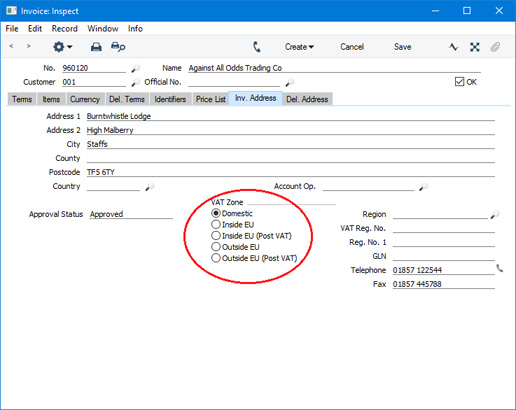
Customers in the "Inside EU" and "Outside EU" Zones will not be charged VAT, irrespective of the VAT Code specified in the transaction row. If you want to charge VAT to such Customers, place them in the Inside EU (Post VAT)" and "Outside EU (Post VAT)" Zones.
When issuing an Invoice to a Customer in the "Inside EU" Zone, you will not charge VAT. The Customer will pay VAT to their tax authority at the domestic rate that would apply had they purchased the Items from a local Supplier. This is sometimes known as the "reverse charge" procedure.
There may be occasions when you need to use the reverse charge procedure in an Invoice that you issue to a domestic Customer. You will not charge VAT in the Invoice and will not account for the VAT to the tax authority. The Customer will account for and pay the VAT. This feature is only available in Lithuania, Poland and the UK (i.e. it is available when the VAT Law in the Company Info setting is "Lithuanian", "Polish" or "Default").
To use the reverse charge procedure in a domestic Invoice, follow these steps:
- In the VAT Codes setting in the Nominal Ledger, create a VAT Code for domestic reverse charge VAT (VAT Code 7 in the illustration below). The VAT percentage in this VAT Code should be the rate at which VAT would be charged in a normal calculation.
If the use of the reverse charge procedure in an Invoice depends on the value of that Invoice, use the Min. and/or Max. Amounts on flip F to specify that value. For example, in the UK, a sale of mobile phones or computer chips can be subject to the reverse charge procedure if the value of the sale is greater than 5000.00. In this case the Minimum should be 5000.00, as shown in the illustration below:
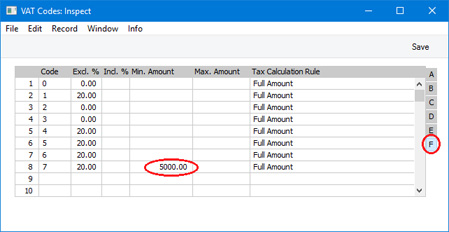
- In the Item records for the Items that you can sell on a reverse charge basis, specify the reverse charge VAT Code on the 'A/C' card:
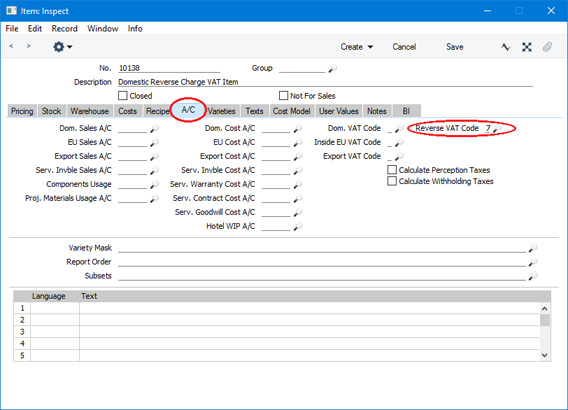
- In order to be able to issue a reverse charge Invoice to a Customer, the Contact record for that Customer must satisfy the following requirements:
- On the 'Company' card, the Type must be "Company". If the Type is "Person", VAT in Invoices will be calculated on a normal basis, not on the reverse charge basis.
- Also on the 'Company' card, you must specify a VAT Reg. No. It is a legal requirement that you must obtain a Customer's VAT registration number before you can issue a reverse charge Invoice to them.
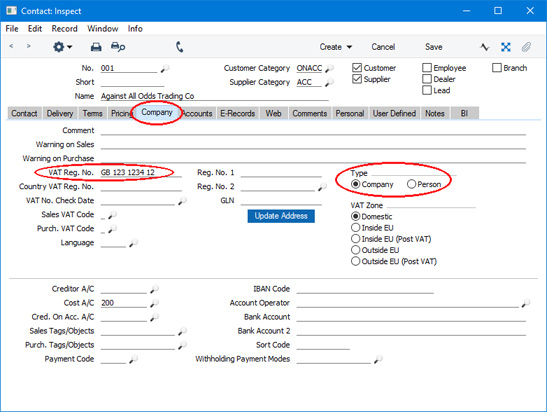
- An option is to select the Reverse VAT option on the 'Terms' card. This option will mean that the use of the reverse charge procedure in an Invoice will not be dependent on the value of the Invoice. In other words, when you sell a reverse charge Item to the Customer, the reverse charge procedure will always be used (i.e. the Min. and Max. Amounts specified in the VAT Code (step 1 above) will be ignored).
Continuing the UK mobile phone example, the reverse charge procedure can usually only be used in an individual Invoice if its value is greater than 5000.00. However, you can also use the reverse charge procedure if you have received an order whose value is greater than 5000.00 that you will deliver and invoice in stages, some or all of which have values of less than 5000.00. Selecting this option will allow you to invoice each stage using the reverse charge procedure.
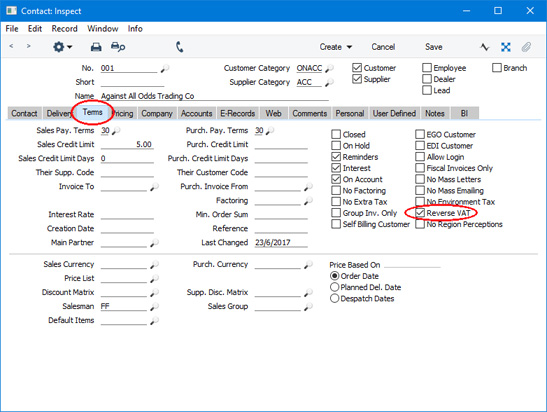
You can prevent users from the changing the Reverse VAT box in Contact records using Access Groups, by denying them access to the 'Qualify for Reverse VAT' Action.
- You can only use the reverse charge procedure in a Quotation, Order or Invoice in which prices exclude VAT. So, if your default setting (specified on the 'VAT / Tax' card of the Account Usage S/L setting) is that Base Prices include VAT (or VAT and TAX), you must assign a Price List in which prices exclude VAT to the Customer.
- When you print a Quotation, Order or Invoice in which you have used the reverse charge procedure, you must have a reference printed on the document to make it clear that the reverse charge applies and that the Customer is required to account for the VAT. You can do this by including the fields listed below in your Form Template designs:
| Field in Form Template | Prints | | | | Header Fields (these print once per Invoice) | | | | Reverse VAT text | In Lithuania, this field will be printed on an Invoice or Credit Note if every row has a Reverse VAT Code (see step 5 below). It prints the text "Atvirkštinis PVM, PVMĮ 96 str.". | | In Poland, this field will be printed on an Invoice or Credit Note if any row has a Reverse VAT Code (see step 5 below). It prints the text "Odwrócony VAT". | | In the UK, this field will be printed on an Invoice or Credit Note as follows:
- In an Invoice in which every row has a Reverse VAT Code (see step 5 below), it will print the text "Reverse charge: Customer to account to HMRC for the reverse charge output tax".
- In an Invoice in which some rows have a Reverse VAT Code, it will print the text "Reverse charge: Customer to account to HMRC for the reverse charge output tax on the VAT exclusive price of items marked reverse charge".
- In a Credit Note in which every row has a Reverse VAT Code, it will print the text "Reverse charge: Customer to account to HMRC for the output tax adjustment".
- In a Credit Note in which some rows have a Reverse VAT Code, it will print the text "Reverse charge: Customer to account to HMRC for the adjustment to reverse charge output tax on the VAT exclusive price of items marked reverse charge".
| | Reverse VAT amount | This field will print the amount in the Reverse VAT field in the Quotation, Order or Invoice i.e. it prints the VAT amount that the Customer should pay to the tax authority. | | | | Row Fields (these print once per row, so remember to specify a Line Height and to set the Format to "Matrix") | | | | Reverse VAT Code | This field will print the Reverse VAT Code in each row. | | Row reverse VAT text | In Lithuania and the UK, this field will print the text "Subject to Reverse VAT Charge" for each row that has a Reverse VAT Code, only in Invoices and Credit Notes in which not every row has a Reverse VAT Code. | | VAT Code | The standard “VAT Code” row field will print the Reverse VAT Code (if there is one) or the VAT Code (otherwise) |
- Enter Quotations, Orders and Invoices in the usual way. If you add an Item in which you have specified a Reverse VAT Code (step 2 above) to the transaction, that Reverse VAT Code will be brought in to the Rvrs field on flip B, providing the Sum in the row satisfies any minimum or maximum requirements specified in the VAT Codes setting (step 1 above) or providing the Customer is one where you have ticked the Reverse VAT option (step 3 iii above). The Reverse VAT field in the footer will display the VAT that the Customer should pay to the tax authority on the reverse charge basis:
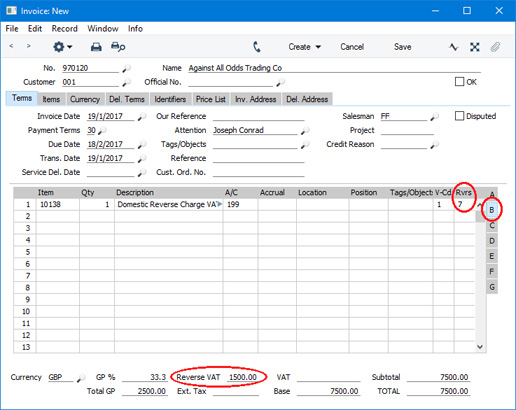
If the Item has a Reverse VAT Code but the Rvrs field remains empty, this will usually be because the Sum in the row does not satisfy the minimum or maximum requirements. It could also be because the Type of the Customer is "Person" (step 2 i above). If the Rvrs field is empty, the row will not be subject to the reverse charge procedure.
The Rvrs and Reverse VAT fields will be updated whenever you change the quantity or price in a row and as you add or remove rows (the minimum and maximum requirements in the VAT Codes setting apply to the Invoice as a whole, not to individual rows, so adding a row could cause the Rvrs field to be updated in an earlier row).
You will not be able to change a row containing an Item with a Reverse VAT Code in an Invoice that was created from an Order or a Delivery. It will also not be possible to add new rows for Items with Reverse VAT Codes. In this situation, the Order and Invoice should be seen as a unified transaction, subject to the same minimum and/or maximum values, so changing the row in the Invoice will not be possible.
- Usually, the Customer's VAT Reg. No. will be brought in to the Quotation, Order or Invoice. If you have not specified a VAT Reg. No. in the Contact record for the Customer (step 2 ii above), the VAT Reg. No. field in the Quotation, Order or Invoice will remain empty. This will mean that it will not be possible to save the record.
- If you are entering an Invoice and you mark it as OK and save, no VAT will be posted from the rows with Reverse VAT Codes (i.e. from the rows in which the Rvrs field is not empty). The Reverse VAT Code from each Invoice row will be copied to the Rvrs field in the corresponding Transaction row:
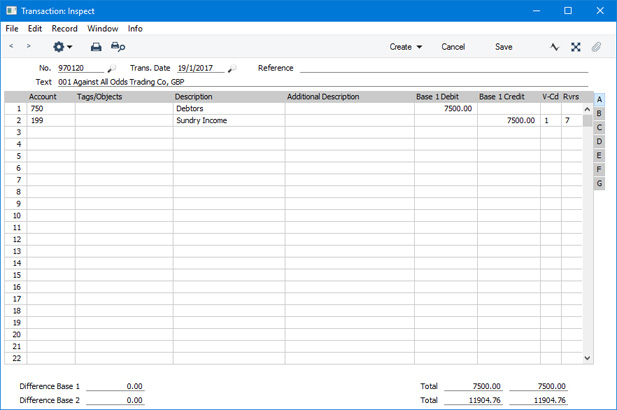
- If you need to create a Credit Note from an Invoice in which you have used the reverse charge procedure, you will not be able to change anything in the matrix in the Credit Note. In other words, you must credit such an Invoice in full, you cannot partially credit such an Invoice.
---
The Invoice register in Standard ERP:
Go back to:
|
